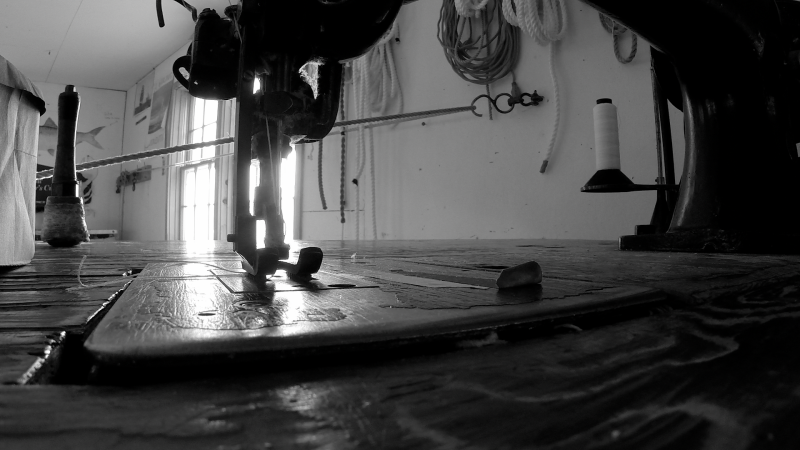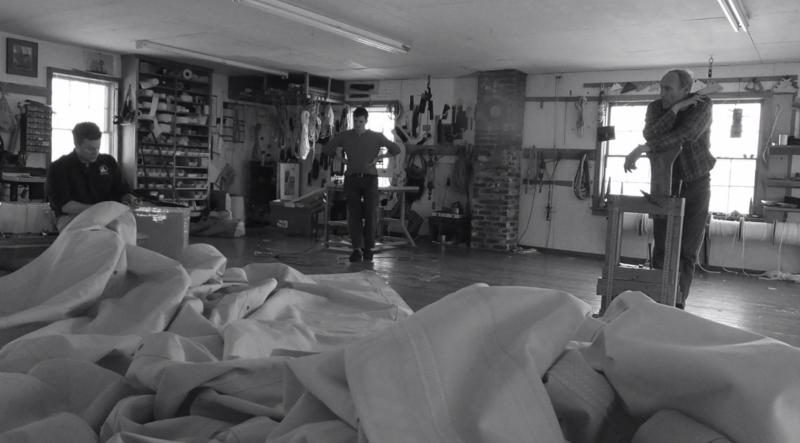Piecing together the past
 An old sewing machine at Nat Wilson’s shop that’s used to seam the sails of the Charles W. Morgan sailing ship. It was not uncommon to have machine sewn sails in the 19th Century. RYAN LEIGHTON/Staff Reporter
An old sewing machine at Nat Wilson’s shop that’s used to seam the sails of the Charles W. Morgan sailing ship. It was not uncommon to have machine sewn sails in the 19th Century. RYAN LEIGHTON/Staff Reporter
 East Boothbay Sailmakers. From left Sam Upton, Adam Yanchunis and a contemplative Nat Wilson. RYAN LEIGHTON/Staff Reporter
East Boothbay Sailmakers. From left Sam Upton, Adam Yanchunis and a contemplative Nat Wilson. RYAN LEIGHTON/Staff Reporter
 An old sewing machine at Nat Wilson’s shop that’s used to seam the sails of the Charles W. Morgan sailing ship. It was not uncommon to have machine sewn sails in the 19th Century. RYAN LEIGHTON/Staff Reporter
An old sewing machine at Nat Wilson’s shop that’s used to seam the sails of the Charles W. Morgan sailing ship. It was not uncommon to have machine sewn sails in the 19th Century. RYAN LEIGHTON/Staff Reporter
 East Boothbay Sailmakers. From left Sam Upton, Adam Yanchunis and a contemplative Nat Wilson. RYAN LEIGHTON/Staff Reporter
East Boothbay Sailmakers. From left Sam Upton, Adam Yanchunis and a contemplative Nat Wilson. RYAN LEIGHTON/Staff Reporter
Nat Wilson’s needles have pierced the cotton canvas of New England’s most treasured sailing ships. In the 40 years the East Boothbay sailmaker has designed, cut and sewn sails, it comes as a slight surprise that his career has come full circle.
Connecticut’s historic Mystic Seaport has contracted Wilson to build 19 square sails for the restoration of the Charles W. Morgan, a 19th century whaling ship that Wilson happens to know quite well.
Wilson first built the demonstration sails for the 133 wooden vessel in 1973. An illustrious topsail bark rig built in 1841, the Charles W. Morgan is currently America's oldest commercial ship still afloat. Mystic Seaport relaunched its signature ship in 2013, and will tour the New England seaboard this summer.
Wilson will once again help send the ship to sea.
“You’re not just restoring the vessel but you’re restoring the living memory of it sailing, and you’re restoring the skills that it takes to maintain it in the future,” Wilson said. “We’ve lost so much in the past historically because we want everything new these days.”
Wilson doesn't work with laminate sails used on today's modern vessels. He prefers to keep things authentic and true to the tradition. His skillful hands have built sails for some of America's most historic ships, including the USS Constitution and Gazela.
Wilson spent some time studying old books and glass plate photographs for the minute details that unlocked the secrets to the Charles W. Morgan.
In June of 2012, cotton cloth arrived in rolls 24 inches wide. It took 6 to 8 months to weave on looms in India. Hemp rope imported from Holland was delivered at the Charles W. Morgan's home port in New Bedford, Mass. Each rope was tarred and spliced with 75 pieces of galvanized steel hardware forged in the town of Newcastle.
Wilson makes the measurements and calls the shots from his East Boothbay shop overlooking the working waterfront. Up in the loft, three apprentices deftly maneuver palms and needles.
“From being on the fleet if you know Nat's name, you know he's made the best sails for the best boats,” said Sam Upton, a fifth year apprentice.
The sail loft is like an open floor democracy. No one is afraid to question something if they don't think it's right. Wilson watches over the sailmakers like a mentor, occasionally offering guidance as the sails come together flawlessly.
Upton, alongside Adam Yanchunis and Mike Bartles, make up Wilson's team of skilled sailmakers. The bulk of the sails for the Charles W. Morgan were straight stitched on sewing machines, the final three sails were stitched by hand. It took 19 weeks seaming 8,000 square feet of canvas by the same time honored process used a century ago.
“You can appreciate what people had to go through, then you have to do what they did in those days,” Wilson said.
Sailmakers are a lot like the sails themselves, Upton said. They are dynamic and subject to external forces. But when done correctly, they achieve lift. One screw up, and it's all over.
“When everyone is on that same page, I think the finished piece rises to the next level,” Upton said.
Making sails for historic ships is a privilege, Wilson said. “It's the only way to carry the ship’s future forward because the living memories are all gone.”
This spring, Wilson's sails will fly from the three masts of the Charles W. Morgan. It's at that moment when his work takes flight; it's most gratifying to watch the ship head to sea.
“When they're full power, and full trim and going along at a good rate and a good clip, it's just an impressive thing to see,” Wilson said.
Related:
Event Date
Address
United States





























